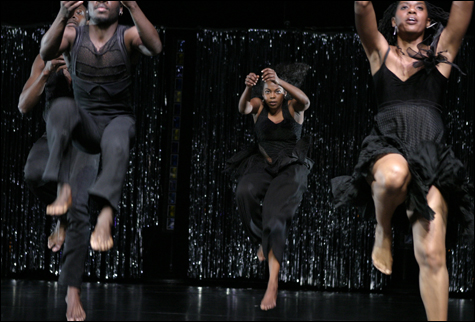
HISTORY’S LINE: In Reggie Wilson’s Tale, the contemporary choreography looked constricted
compared with the traditional dance movements.
|
Tradition: how to preserve it in a globalized modern culture. This was the subject of two completely different performance groups last week, New York’s Reggie Wilson/Fist and Heel and Heisei Nakamura-za from Tokyo.
Fist and Heel, the second in this year’s Summer Stages Dance series at Concord Academy, is a company of dancers and singers from Africa, the Caribbean, and the US. With a playful irony, choreographer Wilson calls his style “Post-African/Neo-HooDoo Modern dance.” The hour-long 2006 work was The Tale: Npinpee Nckutchie and the Tail of the Golden Dek. What he’s trying to encompass, I think, is the rich blend of experience that feeds African-American life.
Riding on a skillfully assembled collage of live and recorded musical sources, The Tale begins and ends with contemporary pop, and it glides from swing to the blues to slave songs, spirituals, gospel, and rap, with infusions of African, Haitian and Latin rhythms. The show doesn’t try to teach you history, but it does show you how one thing led to another and how everything along the line retains something of its past.
In a dark space surrounded by tinsel streamers, the performers emerge, acknowledge one another, and then roll out. Next thing you know, they’re in a circle doing social-dance steps to Jimmie Lunceford’s big band of the 1940s. Wilson stands at the side calling out the steps: Suzie Q, black bottom, truckin’, Charleston. They all involve rhythmic stepping, distinctive arm patterns, and a sensuous body.
The company gradually sorts itself out into dancers (Penelope Kalloo, Michel Kouakou, Edisa Weeks) and singers (Rhetta Aleong, Lawrence A. W. Harding, Reggie Wilson). In successive duets, trios, and groups, they show you traditional and invented stepdancing, often counterpointing one style against another. Wilson’s choreography emphasizes arm gestures to signal expressive angst or pleasure, and to substitute for sticks in a dueling game between two women. The basic stepdance patterns expand from stamping and patting to hopping, striding, stomping, and simulated trance.
As the small group divided, it seemed Wilson was distinguishing between traditional stepdances and his own choreographic by-products. The singers consolidated into a tight cluster, stepping, slapping, and shouting in call-and-response praise songs, while the three dancers worked in more spacious, modern-dance-like unison. At one point, Wilson sat in the audience and clapped irregular rhythms for the dancers to follow. Although the music and dances were always complementary, the contemporary choreography looked constricted, less spontaneous than the singers’ action, in which song, step, and rhythmic exploration flowed directly out of the same impulse.
The performers came across as highly individual despite their communal approach to the movement material. Wilson, solid and low-key, shared a last duet with the diminutive Kouakou. Picking up on the women’s arm games, they segued from thrust-and-parry to full body contact, rolling and tumbling on the floor, still one move at a time. They might have been wrestling, then tenderly holding one another. When the lights went out, they were rolling fast in a circle, head to head, like the spokes in a wheel.
Updaters of traditional forms often think they’re making the form more accessible to unenlightened viewers. At some point, they may create a new fusion form altogether. Or they may make the updated bits so attractive, no one bothers to appreciate the traditional retentions. Wilson’s piece did the opposite.
I wouldn’t say Nakamura Kanzaburo XVIII’s Heisei Nakamura-za undersells kabuki tradition, but it’s a tricky balance the players try to effect. Kanzaburo, who’s been designated a National Living Treasure by the Japanese government, continues a family line of kabuki actors that traces back four centuries. In the plays brought to New York, he dominated his troupe of actors and musicians, playing just about every type in the kabuki stylebook: warrior hero, refined female, ruffian, demon, low comedian. Especially low comedian. The sophisticated Lincoln Center Festival audience cheered its head off for tricks and interpolated shtick and paid less attention to the arcane stylizations that make kabuki unique.
Kanzaburo’s idea is not to modernize kabuki but to bring it to the audience from a less esoteric vantage point. In the comic play Hokaido, his character breaks into the vernacular, speaking directly to the audience in bawdy asides and comments on the plot. He dances like Isadora Duncan, plays Yankee Doodle on a trumpet, imitates American movie heroes. He even leaves the stage to engage audience members in the action. He’s very funny and physically all over the place, but his shenanigans turn an immensely complicated and subtle theater form into a star vehicle.
Opening night the company offered a one-time-only performance of Renjishi, showcasing Kanzaburo’s serious dancing and acting abilities. Renjishi isn’t really a kabuki play but a dance drama of a father lion teaching his sons the skills of survival. First they dance with small lion masks on one hand, The father demonstrates — whirling, wide warrior moves, stamping and fierce two-footed jumping. The sons (Nakamura Kantaro and Nakamura Shichinosuke) imitate his moves, then get sent off on their own as a test. While they pose on the hanamichi (the traditional kabuki runway that provides the actors with an entrance and exit through the audience), the father searches for them. He doesn’t see them, but the audience can see his anxiety as he scans far away and across the landscape, and his joy when they return.